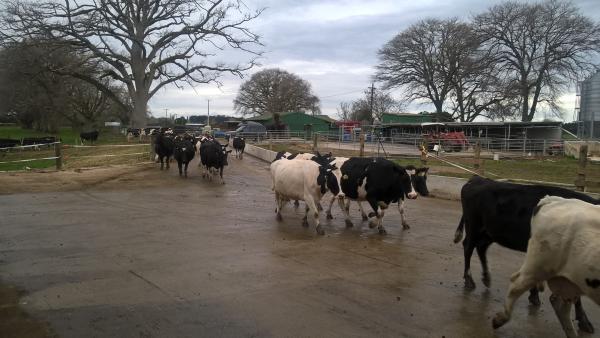Compost barn tour
Calder Stewart staff recently hosted a compost barn tour, taking with us seven interested dairy farmers and a consultant, visiting two successfully managed composting barns, one in the Waikato and the other in the Manawatu.
For those unfamiliar with compost barns these are a loose housing system with no stalls or partitions and have the resting and exercise areas combined. These areas are filled with typically sawdust, wood shavings or other organic compostable materials like Miscanthus grass.
They are a fairly new for housing dairy cattle and require the bedding to be tilled at least twice daily to incorporate air into it and to allow it to dry. By using this method, the cow effluent deposited onto it can be stored within in for months on end and are typically emptied only once per year.
ALLCOCK
Our first visit was to Tony, Fran and Lucas Allcock’s dairy farm who have a compost barn which is in its fourth season of use. It houses their 270 cows and is split in two by a centre feed lane. Cows in each half have two feed faces with feed troughs down the outside of the barn as well as through the centre. Water troughs are located outside the barn so that no spills or leaks interfere with the composting process.

Figure 1: Allcock's walking towards compost barn.
Allcock’s feed all their supplements in the shed with nothing fed out in the paddocks. They have found that, during the heat of the summer, their cows enjoy grazing in the paddocks at night and being in the barn during the day. The cows are feed approximately 10 kgs of supplements per cow per day and this ration includes 7 kgs of home grown maize silage.
When all the barn’s composted bedding is removed it is stored on an old concrete silage bunker until it is spread onto the maize crop paddocks as fertiliser and is the only fertiliser application that those paddocks receive.
Since having their compost barn the Allcock’s per cow production has increased from 380 to 550 kgs ms per cow, a staggering 44% increase.
FRECKLINGTON
The second farm on our tour was that owned by Paul and Christine Frecklington at Tangimoana in the Manawatu, 13 kms south of Bulls. They took over the farm from Paul’s parents in 1967, continuing a legacy of Frecklington family ownership which started in 1904.
The Cartref farm, Cartref is Welsh meaning home, is the smallest of the three dairy farms they own and runs 275 high producing Jersey cows, part of the 1,700 cows they own.
The barn was built 3 years ago and it is used as a welfare tool to provide shelter during the heat of summer and the cold of the winter months. Heat stress on cows is a potential limiting factor on their production and can occur when air temperatures exceed 23°C and relative humidity exceeds 80%. Heat stress can result in a depression of feed intake and lower productivity.
The compost barn houses their 275 cows which have an average production of 650 kgs of milk solids per cow. Part of their herd won a production award at last year’s Jersey NZ awards ceremony producing 652 kgs ms per cow. Some of the herd produce 800 kgs of milk solids.
The cows are sent to pasture at night and allowed to drift back once a gate catch on a timer is released. This has helped eradicate lameness from the herd. They calve in both the spring and autumn and use the barn to calve in. The herd is split calving with the aim being 50:50 autumn and spring.
Their barn which measures 75 meters long by 30 meters wide, has only 300mm of sawdust in it and is tilled daily and emptied once a year. The cows are fed 8 kgs of supplements which is typically maize silage, PKE, straw, soya and kibbled maize.

Figure 2: Frecklington’s grubber
MISCANTHUS
We also met with Peter Brown from Miscanthus NZ who discussed with us the benefits and management of Miscanthus as animal bedding. It is a C4 plant which means it has a far more efficient photosynthesis and is closely related to sugarcane.
Grown from rhizomes, as opposed to seed, it takes approximately three years of growth to produce approx. 30T per Ha under irrigation. That works out to be 15 cu m per tonne and each cow requires 3 cu m of bedding per year. 1 Ha grown would grow sufficient bedding for 100 cows. The seed produced is sterile so will not spread to infest valuable pasture land. It is hardy requiring little inputs. There are currently trials being conducted in Canterbury which I’m keen to visit. It offers a real alternative to wood bedding products and I’m sure we will see more of it grown in the future.

Figure 3: Miscanthus grass
THANKS
I would like to thank the Allcock and Frecklington families for their hospitality in allowing us to visit their farms and learn from them how they use a compost barn to not only improve cow production and animal health but also to take better care of their environment.
I would also like to thank Peter Brown from Miscanthus New Zealand Limited for meeting with us and sharing his knowledge and passion for Miscanthus. Here is a link to the Miscanthus New Zealand Limited website: https://www.miscanthus.co.nz/
